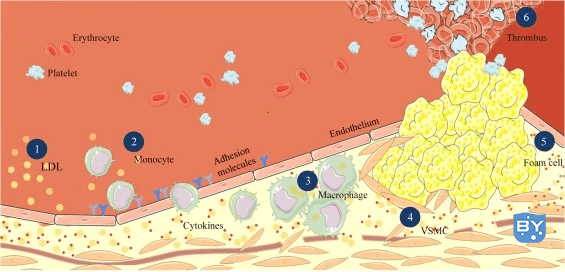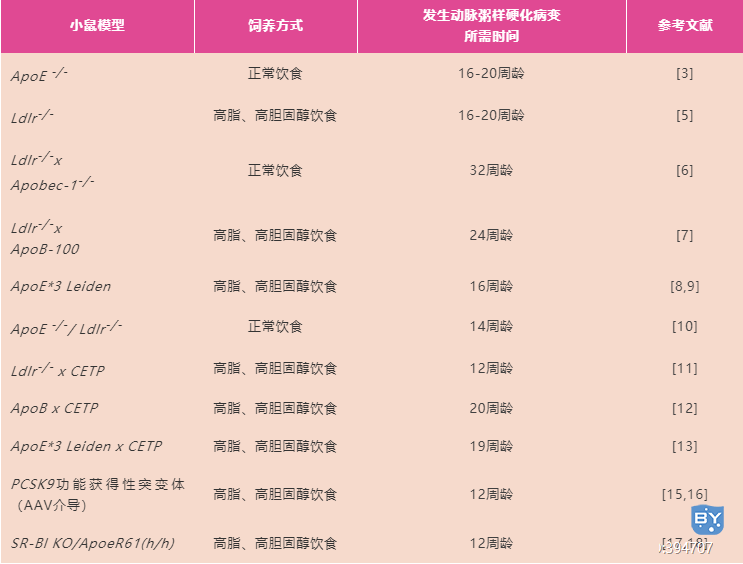
血脂异常是动脉粥样硬化病变发生的使动因素,亦可加速动脉粥样硬化的发生。动脉粥样硬化动物模型的构建始于十九世纪Nikolai Anitschkov等人首次用胆固醇喂养兔子。此后包括非人灵长类动物、兔、狗、猪、大/小鼠等多个物种均曾用于构建此类模型,但小鼠最为常用。主要原因包括:
(1)基因工程难度较小;
(2)妊娠期较短,性价比高;
(3)体积较小,便于饲养;
(4)动脉粥样硬化病变进展相对较快。
但小鼠和人在动脉粥样硬化形成过程中也存在一些生理指标的显著差异。比如,小鼠的心率远高于人类(小鼠为550–700bpm,人类为60–100bpm);小鼠的主要脂蛋白是高密度脂蛋白(HDL),而人类的主要脂蛋白是低密度脂蛋白(LDL),这可能与小鼠缺乏胆固醇酯转移蛋白(CETP)有关。
有学者比较了三种野生型小鼠品系C57BL/6J, BALB/c和C3H动脉粥样硬化的发生发展,这些野生型小鼠品系均给予致动脉粥样硬化的高脂饮食喂养[1]。结果发现C57BL/6J最易发生动脉粥样硬化。此外,通过对某些脂质代谢相关基因的操作改变脂质分布亦可加速动脉粥样硬化病变的发展。

ApoE敲除小鼠
ApoE -/-小鼠是目前最常用的一种转基因小鼠品系[2]。作为一种自发的动脉粥样硬化模型,其与人的动脉粥样硬化进程最为相似。ApoE是极低密度脂蛋白(VLDL) 和高密度脂蛋白(HDL) 的组成部分,参与胆固醇的运输。和人的脂蛋白谱相反,小鼠体内HDL较高,而低密度脂蛋白(LDL)含量较低,其胆固醇主要存在于HDL中。敲除ApoE基因后,胆固醇转而主要分布于VLDL中,其携带的大量胆固醇无法被细胞表面脂蛋白受体结合后降解,发生蓄积导致动脉粥样硬化。研究表明ApoE -/-小鼠可自发形成高胆固醇血症(300-500 mg/dL),并在正常饮食条件下发生显著的动脉粥样硬化病变。而高脂肪/高胆固醇的致动脉粥样硬化饮食会使血浆胆固醇水平升高超过1000 mg/dL,加速动脉粥样硬化进程[3]。ApoE -/-小鼠血浆中三酰甘油水平也比正常小鼠高68%,且不受年龄和性别影响,其高密度脂蛋白只有正常小鼠45%[4]。此类小鼠的病变部位主要发生于主动脉根部、主动脉弓、无名动脉、主动脉分支及肾动脉分叉。正常饮食条件下,早期泡沫细胞病变可在10周内发生。15周后发展成动脉粥样硬化病变。20周后演变成晚期纤维病变。高脂肪/高胆固醇饮食可加速这一致病过程,包括促进胆固醇结晶、坏死核心和钙化的形成。
Ldlr敲除小鼠
低密度脂蛋白受体转基因(Ldlr-/-)小鼠是目前常用的另一种动脉粥样硬化动物模型[5]。该模型的优点是敲除LDL受体(LDLR)除了影响脂蛋白的摄取和清除外,没有其他附加效应。最重要的一点是正常饮食条件下,Ldlr-/-鼠没有明显的高脂血症,只出现轻微的动脉粥样硬化病变。然而,在高脂肪/高胆固醇饲料诱导后,该小鼠可在12周后时即出现主动脉广泛的内膜增厚,内膜表面60%-80%苏丹染色呈阳性;20周时出现明显的高胆固醇血症和动脉粥样硬化病变。因此,不同于ApoE -/-小鼠,研究者可在任何给定时间点对不同月龄的Ldlr-/-小鼠启动高脂肪/高胆固醇饮食,构建致动脉粥样硬化的环境暴露。
其它动脉粥样硬化小鼠模型
此外,也有学者同时靶向两个血脂代谢相关基因构建共敲除小鼠模型。比如,Ldlr-/-小鼠与载脂蛋白B相关基因敲除小鼠交配得到的后代即使正常饮食条件下也表现出高胆固醇血症(300 mg/dL)及广泛的动脉粥样硬化病变[6, 7]。ApoE*3 Leiden小鼠表达对LDLR亲和力较低的人ApoE3变体,导致动脉粥样硬化病变的发生[8, 9]。低密度脂蛋白受体和载脂蛋白E双突变小鼠(ApoE -/-/Ldlr-/-)比ApoE -/-小鼠表现出更严重的高胆固醇血症和动脉粥样硬化病变[10]。由于小鼠不表达降低HDL的CETP,因此,也有学者利用表达人CETP的转基因小鼠与Ldlr-/-[11]、人ApoB-100[12]或ApoE*3 Leiden小鼠[13]交配的后代鼠构建动脉粥样硬化模型。前蛋白转化酶枯草杆菌素/ kexin 9型(PCSK9)通过降解肝脏中的LDLR提高血浆LDL胆固醇水平[14]。研究表明腺相关病毒(AAV)介导的PCSK9过表达在高脂饮食条件下可于相对早期时间点(12周)诱导出高胆固醇血症和动脉粥样硬化,而无需基因操作[15, 16]。高密度脂蛋白受体SR-BI(清道夫受体B类,I型)和ApoE基因双敲纯合子突变小鼠(SR-BI KO/ApoeR61(h/h)即使在低脂饮食喂养条件下也表现出与人类冠心病共有的一系列病理学特征,如高胆固醇血症、心肌梗死、心功能不全(心脏增大、左室射血分数降低、心电图异常)和早死(平均6周龄)[17, 18]。

内容源自:百度学术
参考文献:
[1] Paigen B, Holmes PA, Mitchell D and Albee D. Comparison of atherosclerotic lesions and HDL-lipid levels in male, female, and testosterone-treated female mice from strains C57BL/6, BALB/c, and C3H. Atherosclerosis 1987; 64: 215-221.
[2] Piedrahita JA, Zhang SH, Hagaman JR, Oliver PM and Maeda N. Generation of mice carrying a mutant apolipoprotein E gene inactivated by gene targeting in embryonic stem cells. Proc Natl Acad Sci U S A 1992; 89: 4471-4475.
[3] Zhang SH, Reddick RL, Burkey B and Maeda N. Diet-induced atherosclerosis in mice heterozygous and homozygous for apolipoprotein E gene disruption. J Clin Invest 1994; 94: 937-945.
[4] Jawień J, Nastaek P and Korbut R. Mouse models of experimental atherosclerosis. J Physiol Pharmacol 2004; 55: 503-517.
[5] Ishibashi S, Herz J, Maeda N, Goldstein JL and Brown MS. The two-receptor model of lipoprotein clearance: tests of the hypothesis in "knockout" mice lacking the low density lipoprotein receptor, apolipoprotein E, or both proteins. Proc Natl Acad Sci U S A 1994; 91: 4431-4435.
[6] Powell-Braxton L, Véniant M, Latvala RD, Hirano KI, Won WB, Ross J, Dybdal N, Zlot CH, Young SG and Davidson NO. A mouse model of human familial hypercholesterolemia: markedly elevated low density lipoprotein cholesterol levels and severe atherosclerosis on a low-fat chow diet. Nat Med 1998; 4: 934-938.
[7] Sanan DA, Newland DL, Tao R, Marcovina S, Wang J, Mooser V, Hammer RE and Hobbs HH. Low density lipoprotein receptor-negative mice expressing human apolipoprotein B-100 develop complex atherosclerotic lesions on a chow diet: no accentuation by apolipoprotein(a). Proc Natl Acad Sci U S A 1998; 95: 4544-4549.
[8] van Vlijmen BJ, van den Maagdenberg AM, Gijbels MJ, van der Boom H, HogenEsch H, Frants RR, Hofker MH and Havekes LM. Diet-induced hyperlipoproteinemia and atherosclerosis in apolipoprotein E3-Leiden transgenic mice. J Clin Invest 1994; 93: 1403-1410.
[9] Leppnen P, Luoma JS, Hofker MH, Havekes LM and Yl-Herttuala S. Characterization of atherosclerotic lesions in apo E3-leiden transgenic mice. Atherosclerosis 1998; 136: 147-152.
[10] Witting PK, Pettersson K, Ostlund-Lindqvist AM, Westerlund C, Eriksson AW and Stocker R. Inhibition by a coantioxidant of aortic lipoprotein lipid peroxidation and atherosclerosis in apolipoprotein E and low density lipoprotein receptor gene double knockout mice. Faseb j 1999; 13: 667-675.
[11] Masucci-Magoulas L, Goldberg IJ, Bisgaier CL, Serajuddin H, Francone OL, Breslow JL and Tall AR. A mouse model with features of familial combined hyperlipidemia. Science 1997; 275: 391-394.
[12] Zuckerman SH, Evans GF, Schelm JA, Eacho PI and Sandusky G. Estrogen-mediated increases in LDL cholesterol and foam cell-containing lesions in human ApoB100xCETP transgenic mice. Arterioscler Thromb Vasc Biol 1999; 19: 1476-1483.
[13] de Vries-van der Weij J, Zadelaar S, Toet K, Havekes LM, Kooistra T and Rensen PC. Human CETP aggravates atherosclerosis by increasing VLDL-cholesterol rather than by decreasing HDL-cholesterol in APOE*3-Leiden mice. Atherosclerosis 2009; 206: 153-158.
[14] Lagace TA, Curtis DE, Garuti R, McNutt MC, Park SW, Prather HB, Anderson NN, Ho YK, Hammer RE and Horton JD. Secreted PCSK9 decreases the number of LDL receptors in hepatocytes and in livers of parabiotic mice. J Clin Invest 2006; 116: 2995-3005.
[15] Bjrklund MM, Hollensen AK, Hagensen MK, Dagnaes-Hansen F, Christoffersen C, Mikkelsen JG and Bentzon JF. Induction of atherosclerosis in mice and hamsters without germline genetic engineering. Circ Res 2014; 114: 1684-1689.
[16] Roche-Molina M, Sanz-Rosa D, Cruz FM, García-Prieto J, López S, Abia R, Muriana FJ, Fuster V, Ibáez B and Bernal JA. Induction of sustained hypercholesterolemia by single adeno-associated virus-mediated gene transfer of mutant hPCSK9. Arterioscler Thromb Vasc Biol 2015; 35: 50-59.
[17] Braun A, Zhang S, Miettinen HE, Ebrahim S, Holm TM, Vasile E, Post MJ, Yoerger DM, Picard MH, Krieger JL, Andrews NC, Simons M and Krieger M. Probucol prevents early coronary heart disease and death in the high-density lipoprotein receptor SR-BI/apolipoprotein E double knockout mouse. Proc Natl Acad Sci U S A 2003; 100: 7283-7288.
[18] Zhang S, Picard MH, Vasile E, Zhu Y, Raffai RL, Weisgraber KH and Krieger M. Diet-induced occlusive coronary atherosclerosis, myocardial infarction, cardiac dysfunction, and premature death in scavenger receptor class B type I-deficient, hypomorphic apolipoprotein ER61 mice. Circulation 2005; 111: 3457-3464.
 文章推荐
文章推荐